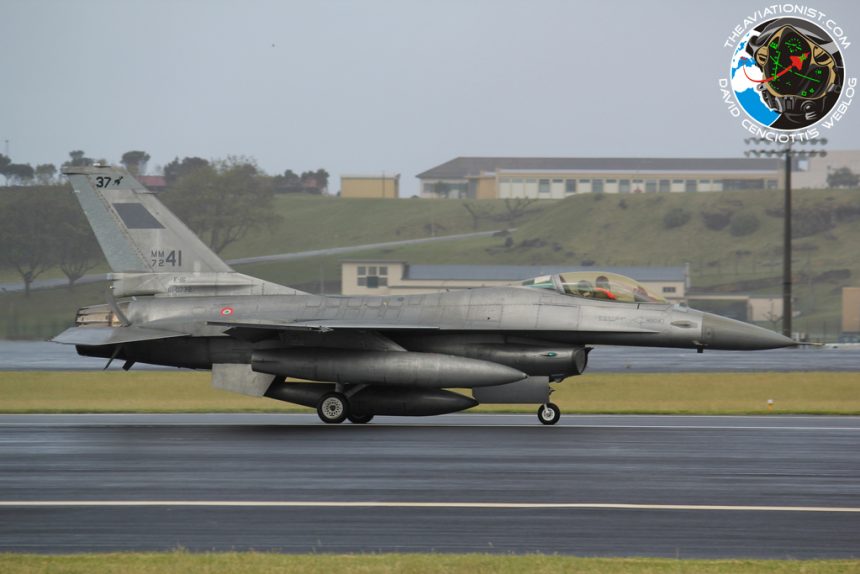Updated May 18, 2012 17.00 GMT
On May 8, eight of the remaining U.S. F-16 fighter jets leased by the Italian Air Force to strengthen Italy’s air defense until the full maturity of the Eurofighter Typhoon made a stopover at Lajes Field, Azores, on their way back to the U.S.
The aircraft had departed from Trapani, in Sicily, and headed towards North America as “Retro 31”, a flight of six “Vipers” (as the F-16 is nicknamed in the fighter pilots community) accompanied by a 22ARW KC-135R tanker and a supporting Italian C-130.
The remaining two planes, used as spares and arriving via Monte Real near Leiria, in the western coast of mainland Portogallo, returned to Trapani where they will remain with the past 8 ones for a few more weeks, until the Italian Air Force officially retires the type on May 25.
Miguel Santos, a retired PoAF Lt.Col. and an aircraft spotter and photographer who lives in Terceira island, Azores, took the following interesting images.
Image credit: Miguel Santos
The Italian Vipers, were returned to the to Davis-Monthan AFB, Arizona, where the aircraft will be kept in storage by the 309th Aerospace Maintenance and Regeneration Group (AMARG) at the local “Boneyard”.
Efficient, combat proven planes, once again cocooned, in a scrap yard.
Under Peace Caesar program, the Italian Air Force purchased a total 45,000 flying hours between 2004 and 2010 (then extended to 47,000 until the first half of 2012), with all the necessary logistic support, of a fleet composed by 30 F-16A Block 15 ADF (Air Defense Fighter) upgraded with the “Falcon Up” and “Falcon 2020” modifications, 3 F-16B Block 10 OCU (Operational Capabilities Upgrade) and a single F-16B ADF. Another 4 twin seats airframes would have been delivered to the ItAF to be cannibalized for spare parts.
The first batch of F-16s were returned to the U.S. in 2010.
During the recent air war in Libya, the Italian F-16ADF of the 18° Gruppo flew more than 1,559 flying hours and 348 missions since the early stages of US-coordinated Operation Odyssey Dawn begun on Mar. 19, 2011.
Flying also in a “heavy” configuration, that included two drop tanks, four AMRAAM (Advanced Medium Range Air-to-Air Missiles) and two AIM-9L Sidewinders, the Squadron’s “Vipers” escorted the first Italian SEAD packages inside the Libyan airspace. With the beginning of NATO’s Operation Unified Protector at 06.00GMT on Mar. 31, 2011 and until the end of the air campaign at 23.59 GMT on Oct. 31, 2011, the Italian F-16s, alongside all the other Italian Air Force assets under the Task Group Air “Birgi”, flew air defense and combat air patrol missions required to enforce the No-Fly Zone over Libya and to ensure the air superiority needed to successfully accomplish the assigned mission.
Furthermore, in connection with the Libyan crisis, the 18th Squadron ensured the Quick Reaction Alert service at an heightened level of readiness with F-16s ready to take off in few minutes in order to intercept and face any suspicious aircraft.
Related articles
- Have you ever seen a picture of a fighter plane towing a radar decoy? Here it is (theaviationist.com)
- Piper 28 intercepted by F-16s in Air Force One airspace violation: a couple of lessons to be learned (theaviationist.com)
- “Viper Drone”: Boeing QF-16 aerial target for U.S. Air Force makes first flight (theaviationist.com)
- There Are Two F-16s Hiding in This Picture [Image Cache] (gizmodo.com)
- Exclusive: F-16 gets killed by Typhoon during air combat training in first Eurofighter HUD capture ever. (theaviationist.com)
- U.S. Air Force goes East: more than two dozen U.S. F-16s in Bulgaria for a month-long exercise with local Migs (theaviationist.com)
- “Yes we can”: KC-767 refueling another KC-767 (theaviationist.com)
- Sixty F-16s taxiing at Kunsan air base in one of the greatest show of force ever: that’s a record-breaking Elephant Walk! (theaviationist.com)
- Belgian Air Force F-16s refueling from U.S. tanker over Afghanistan. With boom operator’s audio (and some wasted fuel…) (theaviationist.com)
- A brand new, combat-proven, next generation tanker: on board Italy’s Boeing KC-767A (theaviationist.com)



















